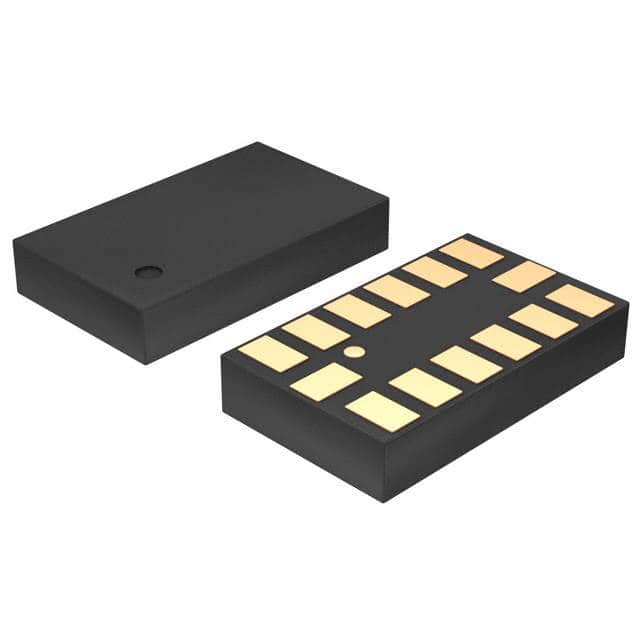Lihat spesifikasi untuk detail produk.

LSM303DLHC
Introduction
The LSM303DLHC is a 3D accelerometer and 3D magnetometer module designed for use in various electronic applications. This versatile sensor module offers precise and reliable measurement capabilities, making it suitable for a wide range of applications.
Product Category
The LSM303DLHC belongs to the category of motion sensing devices and is specifically designed as a 3D accelerometer and 3D magnetometer module.
Basic Information Overview
- Use: The LSM303DLHC is used for measuring acceleration and magnetic fields in three dimensions.
- Characteristics: It features high accuracy, low power consumption, and small form factor.
- Package: The module is available in a compact surface-mount package.
- Essence: Its essence lies in providing accurate and reliable motion and magnetic field data.
- Packaging/Quantity: The LSM303DLHC is typically supplied in tape and reel packaging with varying quantities based on customer requirements.
Specifications
- Accelerometer Range: ±2g/±4g/±8g/±16g selectable full scale
- Magnetometer Range: ±1.3/±1.9/±2.5/±4.0/±4.7/±5.6/±8.1 gauss selectable full scale
- Operating Voltage: 2.16V to 3.6V
- Interface: I2C and SPI
- Operating Temperature Range: -40°C to +85°C
Detailed Pin Configuration
The LSM303DLHC module has a standard pin configuration with pins allocated for power supply, communication interface, and sensor outputs. The detailed pin configuration is as follows:
| Pin Name | Function | |----------|----------------| | VDD | Power Supply | | GND | Ground | | SDA/SDI | Serial Data In | | SCL/SCK | Serial Clock | | SA0 | Address Select | | SDO/SDO | Serial Data Out |
Functional Features
- Dual Sensor Module: Combines both accelerometer and magnetometer functionalities in a single module.
- High Accuracy: Provides precise measurement of acceleration and magnetic fields.
- Low Power Consumption: Suitable for battery-powered applications.
- Digital Output: Offers digital output for easy interfacing with microcontrollers and other digital systems.
Advantages and Disadvantages
Advantages
- Versatile: Suitable for a wide range of applications.
- Compact Size: Small form factor allows for integration into space-constrained designs.
- Low Power: Ideal for battery-powered devices.
Disadvantages
- Limited Range: The selectable full-scale ranges may not cover all application requirements.
- Sensitivity to Interference: External magnetic interference can affect magnetometer readings.
Working Principles
The LSM303DLHC utilizes microelectromechanical systems (MEMS) technology for the accelerometer and anisotropic magnetoresistive (AMR) technology for the magnetometer. The accelerometer measures acceleration by detecting changes in capacitance due to motion, while the magnetometer uses AMR sensors to measure the magnetic field.
Detailed Application Field Plans
The LSM303DLHC finds applications in various fields, including: - Consumer Electronics: Used in smartphones, tablets, and gaming devices for orientation sensing and motion tracking. - Automotive: Integrated into vehicle navigation systems and advanced driver-assistance systems for heading and tilt sensing. - Industrial Automation: Employed in robotics and machinery for position monitoring and gesture recognition.
Detailed and Complete Alternative Models
- LSM303C: Upgraded version with improved performance and additional features.
- HMC5883L: Standalone 3-axis magnetometer with similar functionality.
- ADXL345: Alternative 3-axis accelerometer module with digital output.
In conclusion, the LSM303DLHC is a highly versatile and reliable 3D accelerometer and 3D magnetometer module that caters to diverse application needs. With its compact size, low power consumption, and high accuracy, it serves as an essential component in various electronic systems.
Word Count: 598
Sebutkan 10 pertanyaan dan jawaban umum terkait penerapan LSM303DLHC dalam solusi teknis
Sure, here are 10 common questions and answers related to the application of LSM303DLHC in technical solutions:
What is LSM303DLHC?
- The LSM303DLHC is a 3-axis accelerometer and 3-axis magnetometer module designed for motion-sensing applications.
What are the key features of LSM303DLHC?
- The key features include high resolution, low power consumption, I2C/SPI digital output interface, and programmable interrupt generators for free-fall, motion detection, and magnetic field detection.
How can LSM303DLHC be used in orientation sensing applications?
- LSM303DLHC can be used to detect the orientation of an object by measuring the Earth's magnetic field and gravity, allowing for accurate tilt-compensated compass heading calculations.
What are some common applications of LSM303DLHC?
- Common applications include electronic compassing, map rotation, GPS navigation systems, gaming and virtual reality input devices, and tilt-compensated compasses.
How does LSM303DLHC help in motion detection?
- LSM303DLHC can detect motion and acceleration in three dimensions, making it suitable for applications such as pedometers, activity monitoring, and gesture recognition.
Can LSM303DLHC be used in wearable devices?
- Yes, LSM303DLHC's small form factor and low power consumption make it suitable for integration into wearable devices such as fitness trackers and smartwatches.
What are the power requirements for LSM303DLHC?
- LSM303DLHC operates on a supply voltage range of 2.16V to 3.6V, making it compatible with a wide range of power sources.
How can LSM303DLHC be calibrated for accurate measurements?
- Calibration involves compensating for hard-iron and soft-iron effects in the magnetometer data, and ensuring proper alignment and mounting to minimize errors in the accelerometer readings.
What are the communication interfaces supported by LSM303DLHC?
- LSM303DLHC supports both I2C and SPI digital communication interfaces, providing flexibility for integration with various microcontrollers and systems.
Are there any specific considerations for PCB layout when using LSM303DLHC?
- Yes, proper grounding, decoupling capacitors, and minimizing magnetic interference from other components are important considerations for optimizing the performance of LSM303DLHC on the PCB.
I hope these questions and answers provide a good overview of the application of LSM303DLHC in technical solutions! If you have any more specific questions, feel free to ask.

